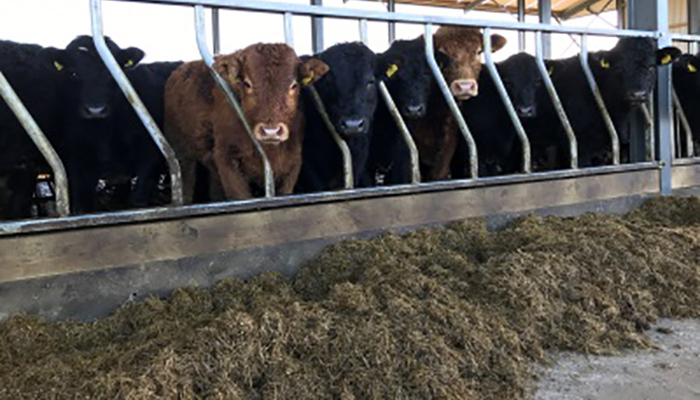19 November 2023
A guide on winter dosing products

With numerous products, brands and classes of anthelmintic available, Catherine Egan, Teagasc Beef Specialist, touches on the importance of winter dosing, while highlighting a useful guide from Animal Health Ireland for use when selecting the correct dosing products to use on your farm.
Winter housing provides an opportunity to clear animals of any parasitic infestations they may have picked up over the grazing season. Additionally, addressing parasitic challenges now will mean that animals won’t be a source of infection when returned to pasture next year.
Although a cost to the system, the benefits in terms of maintaining animal performance more than outweigh the cost of an adequate dosing strategy this winter. Remember, the winter housing period is the most expensive period on beef farms nationally, so animals need to be perform.
Internal parasites
Farmers need to be aware of what parasitic challenges exist on their farms. Dosing strategies should provide sufficient cover from both lungworm and stomach worm; products covering inhibited larvae of the latter need to be factored in when selecting a suitable anthelmintic / dosing product.
The development of anthelmintic resistance in stomach worm populations also needs to be considered. To put it simply, anthelmintic resistance is where wormers no longer work as effectively in clearing the worm burden. To prevent this issue worsening, farmers need to be aware of which products are effective on their farm, dose animals based on weight – don’t under dose – and alternate dosing products throughout the year. More information on anthelmintic resistance is available here.
Additionally, depending on the farm’s location and risk factors, dosing for fluke – particularly liver fluke – may be required. After a mild and wet summer, the prevalence of liver fluke may be higher and this is echoed in the recently published Department of Agriculture, Food and the Marine Liver Fluke Forecast. When assessing the need to treat for this parasite, pay careful attention to the Beef HealthCheck reports, produced by Animal Health Ireland and available on the ICBF website, previous fluke history and/or faecal samples confirming the presence of this parasite on your farm.
Also read: Vigilance required as liver fluke prevalent across many areas
Care is also required when selecting products to control liver fluke, as the parasite has three stages during its lifecycle – early immature (first 5-6 weeks), immature fluke (6-10/11 weeks) and adult fluke (11+ weeks). Not all products cover all stages of liver fluke infestation, so careful examination of the product label is needed before dosing to identify which stages are treated and when is the optimum time to dose after housing.
Also read: The successful control of liver fluke
Another member of the fluke family – this time rumen fluke – is present on many farms this year and its presence has been highlighted in faecal samples taken by farmers over the past number of years. Although a parasitic infection, it does not affect performance for most and dosing should only be carried out if all other avenues have been exhausted. Not all flukicides are effective in treating this parasite and only members of the oxyclozanide class – such as Zanil and Levafas Diamond – offer effective treatment. Overuse of these products where there is not actually a need based on animal performance can result in the development of resistance in the future, so caution on their use for the ‘routine’ treatment of rumen fluke is strongly advised. If rumen fluke is suspected on your farm, the best route is to have a discussion with your vet.
External parasites
Infestations with lice are typically the primary concern when it comes to treating external parasites in cattle. Infestations are typically highest in late winter when animals are housed, environmental temperature drops and cattle’s coats are thick – thus creating a humid environment for lice to flourish. Two types of lice are of concern in Ireland; these are biting lice – which feed on skin and hair – and suckling lice, which burrow into the skin and feed on bone.
The lifecycle of these parasites is typically completed in 2-3 weeks, so select products with a >3 week persistency. Before completing this treatment, however, have all animals housed and do not introduce new or untreated animals to the shed. Many farmers opt to clip the backs of cattle when using a pour-on to treat this parasite. Along with allowing excess heat to leave the animal’s body, thus reducing the potential risk of pneumonia occurring, it removes the shelter area for lice to hide and creates a ‘target zone’ for the application of pour-on lice treatments.
A useful guide on products for parasite control
Animal Health Ireland (AHI) recently published a useful guide which lists the products available in Ireland for parasite control in cattle this year. This guide groups products on the basis of their drug class or use (white, yellow, clear, flukicides, combination products, products for external parasites or coccidiostats) and provides key information on the species targeted and the meat and milk withdrawal periods.
Before going out to purchase products to complete your winter dosing programme, it is advisable to study this guide to ensure the potential products purchased are effective against the parasites you wish to target. This guide is available on the Animal Health Ireland website.
